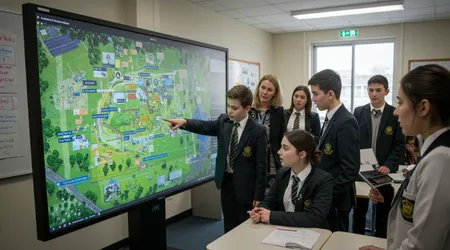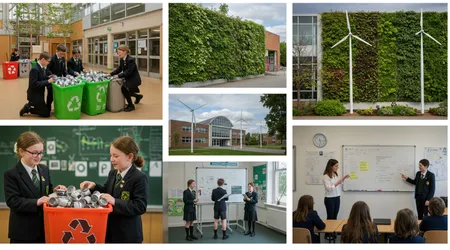Climate Education Must-Haves: Sustainability Plans in Every UK School by Sept ’25

Climate Education Must-Haves are no longer optional they’re a necessity for shaping a sustainable future.
As the UK races toward its 2030 goal of becoming a world leader in sustainability within education, the Department for Education (DfE) has mandated that all schools, from nurseries to universities, implement Climate Action Plans and appoint sustainability leads by September 2025.
This directive, rooted in the 2022 Sustainability and Climate Change Strategy, isn’t just policy it’s a call to action for schools to empower students, transform curricula, and reimagine school estates.
Why should every classroom become a hub for environmental change? This article explores the essentials of Climate Education Must-Haves, offering practical insights, real-world examples, and a clear path for schools to meet this ambitious deadline.
From curriculum integration to estate management, we’ll unpack what’s needed to make sustainability a cornerstone of UK education.
The urgency of this mandate cannot be overstated. Climate change is reshaping our world, with 54.8% of young people aged 17–25 in England reporting climate-related distress in 2023, according to NHS research.
Schools are uniquely positioned to turn anxiety into agency, equipping students with knowledge and skills to tackle environmental challenges.
By embedding sustainability into every facet of education, from science lessons to school grounds, the UK can foster a generation ready to lead in a net-zero world.
This isn’t about ticking boxes it’s about redefining how education prepares young people for a planet in crisis. Let’s dive into the key components of Climate Education Must-Haves and how schools can rise to the challenge.
Integrating Climate Education into the Curriculum
Embedding climate education across subjects is critical for preparing students. The DfE’s strategy emphasizes weaving sustainability into science, geography, and citizenship.
By 2025, a new Natural History GCSE will launch, focusing on ecosystems and conservation. Schools must go beyond siloed lessons, integrating Climate Education Must-Haves holistically.
For example, at Greenview Secondary in Bristol, teachers blend climate science into English by analyzing environmental poetry.
This cross-curricular approach sparks critical thinking and emotional engagement. Geography lessons can explore local flood risks, making climate impacts tangible.
Such methods ensure students see sustainability as a lived reality, not an abstract concept.
Primary schools like Oakwood Academy in Manchester use storytelling to teach young children about renewable energy.
++ Ofsted Inspection Overhaul: How New ‘Report Card’ Ratings Could Change Your School
By personifying wind turbines as “heroes” saving the planet, they make complex ideas accessible. This creative approach fosters early environmental awareness, proving that Climate Education Must-Haves can start young.
The challenge lies in teacher training. Many educators lack confidence in delivering climate-focused lessons.
The DfE’s carbon literacy training, promised for all sustainability leads by 2025, must extend to all staff. Schools can leverage free resources from the Sustainability Support for Education hub to upskill teachers effectively.

Appointing Sustainability Leads: The Heart of Change
Every school must appoint a sustainability lead by September 2025 to champion Climate Education Must-Haves.
This role drives Climate Action Plans, ensuring accountability and progress. Leads don’t need to be experts they need passion, vision, and authority to inspire change across their institutions.
Take St. Mary’s Primary in Leeds, where the sustainability lead, a former geography teacher, rallied students to create a school garden.
This initiative reduced carbon footprints and became a living classroom for biodiversity lessons. Such leadership transforms schools into sustainability hubs, proving the role’s impact.
Also read: Cost of Living Impact on University Students in the UK
Multi-academy trusts like United Learning Trust show how leads can collaborate across schools. Their sustainability journey, highlighted by the DfE, includes shared resources and peer mentoring.
This model ensures smaller schools aren’t left behind, amplifying the reach of Climate Education Must-Haves.
However, the role’s success depends on support. Without adequate funding or time, leads risk burnout.
The DfE must clarify expectations and provide robust backing, such as regional Climate Ambassadors, to prevent this critical role from becoming a token gesture.
Crafting Effective Climate Action Plans
A Climate Action Plan is the backbone of Climate Education Must-Haves, guiding schools toward net-zero and resilience.
The DfE’s Sustainability Support for Education hub offers step-by-step guidance, tailored to school size and needs. Plans must address curriculum, estates, and community engagement.
For instance, Hilltop College in Birmingham used the hub to create a plan reducing energy use by 15% through smart meters.
Their strategy included student-led audits, empowering pupils to monitor emissions. This hands-on approach builds skills and ownership, key to sustainable change.
The National Education Nature Park, launched in 2023, inspires plans by connecting school grounds into a virtual biodiversity network.
Read more: Skills England Launch: What the New Agency Means for Apprentices and Colleges
Over 4,000 schools have mapped two million square meters of habitats, equivalent to 1,600 Olympic swimming pools. This initiative shows how plans can blend education with environmental impact.
Yet, ambiguity around repercussions for missing the September 2025 deadline creates uncertainty. Schools need clear incentives, not just public progress reports.
The DfE should consider grants or recognition, like the Eco-Schools Green Flag, to motivate compliance.
Below is a table summarizing key elements of a Climate Action Plan, based on DfE guidance:
| Component | Description | Example Action |
|---|---|---|
| Curriculum Integration | Embed sustainability across subjects | Geography lessons on local climate impacts |
| Estate Management | Reduce emissions via energy-efficient measures | Install smart meters |
| Biodiversity Enhancement | Increase green spaces and wildlife habitats | Create a school pollinator garden |
| Community Engagement | Involve students, parents, and local groups | Host a sustainability fair |
Empowering Students Through Practical Engagement
Students are at the heart of Climate Education Must-Haves, and their involvement drives meaningful change.
The DfE’s Climate Leaders Award recognizes student-led projects, like building bug hotels or mapping biodiversity. These initiatives teach practical skills while fostering agency.
At Riverside Academy in London, students launched a “Zero Waste Week,” reducing cafeteria waste by 20%.
This project, inspired by the Let’s Go Zero campaign, empowered pupils to lead peers. Such initiatives show students their actions matter, countering climate anxiety with purpose.
The National Education Nature Park engages students in citizen science, like monitoring wildlife.
Data uploaded to its platform aids Natural History Museum research, giving students a role in real-world conservation. This approach makes Climate Education Must-Haves tangible and impactful.
However, engagement must be inclusive. A 2025 UCL survey found girls and students from advantaged backgrounds show stronger interest in climate topics.
Schools must ensure all students, regardless of gender or socio-economic status, feel empowered to participate.
Transforming School Estates for Sustainability

School estates are critical to Climate Education Must-Haves, with the DfE targeting net-zero buildings by 2030.
Since 2021, new schools are designed for a 2°C temperature rise, future-proofed for 4°C. Smart meters and energy management systems are key to reducing emissions.
Consider Westfield School in Sheffield, which retrofitted classrooms with LED lighting, cutting energy costs by 10%.
Students analyzed usage data, linking estate changes to curriculum learning. This synergy shows how estates can double as educational tools.
The Gen Zero Platform, showcased at COP26, aims to build four schools and one college by 2025 using ultra-low carbon methods.
These buildings set a standard, but retrofitting older estates remains a challenge. Schools need funding to upgrade without disrupting education.
Biodiversity is equally vital. The National Education Nature Park encourages schools to create green spaces, like rain gardens.
These not only enhance ecosystems but also teach students about urban habitat restoration, reinforcing the practical side of sustainability.
Overcoming Barriers to Implementation
Implementing Climate Education Must-Haves faces hurdles, from curriculum constraints to resource shortages.
A 2025 BERA study highlighted three key barriers: lack of curriculum emphasis, limited teacher training, and poor student-management communication. Schools must address these creatively.
For example, small rural schools often lack resources for robust plans.
Partnering with local trusts or Climate Ambassadors can bridge this gap, offering expertise and shared initiatives. Collaboration ensures no school is left behind in meeting the 2025 deadline.
Teacher workload is another concern. Integrating sustainability shouldn’t add burdens.
The DfE’s free online resources and regional networks can streamline efforts, but schools need dedicated time for professional development to build confidence in delivering climate education.
Engaging diverse student voices is crucial. Schools must create platforms, like eco-councils, to ensure all perspectives shape plans. This inclusivity fosters a shared vision, turning challenges into opportunities for collective action.
A Vision for a Greener Future
The September 2025 deadline is a stepping stone to a broader vision: a UK education sector leading globally in sustainability by 2030.
Climate Education Must-Haves are about more than compliance they’re about inspiring a generation. Schools must act as catalysts, blending education, action, and hope.
Imagine schools as ecosystems, where every lesson, building, and garden nurtures environmental stewardship.
By embedding sustainability, we equip students to navigate a warming world with resilience and creativity. The DfE’s strategy is a blueprint, but its success lies in collective commitment.
Every small act planting a tree, auditing energy, or debating climate justice builds momentum.
Schools that embrace Climate Education Must-Haves will not only meet policy goals but also shape a future where young people thrive as environmental leaders.
Conclusion
The mandate for Climate Action Plans by September 2025 marks a pivotal moment for UK education. Climate Education Must-Haves demand bold action: integrating sustainability into curricula, empowering sustainability leads, crafting robust plans, engaging students, and transforming estates.
These steps aren’t just policy they’re a moral imperative to prepare young people for a planet in flux.
With 54.8% of youth experiencing climate distress, schools can transform anxiety into action, fostering hope through education.
The journey won’t be easy, but with DfE resources, community collaboration, and student passion, UK schools can lead the charge toward a sustainable future. Let’s make every classroom a beacon of change because the planet can’t wait.
Frequently Asked Questions
What is a Climate Action Plan, and why is it mandatory?
A Climate Action Plan outlines a school’s strategy for sustainability, covering curriculum, estates, and engagement. The DfE mandates it by September 2025 to align with net-zero goals.
Who can be a sustainability lead?
Any staff member with passion and authority can be a sustainability lead. They champion the Climate Action Plan, with DfE training supporting their role.
How can schools access support for sustainability?
The DfE’s Sustainability Support for Education hub offers free resources, while Climate Ambassadors provide on-the-ground guidance. Eco-Schools and Let’s Go Zero also offer tools.
What happens if a school misses the 2025 deadline?
The DfE hasn’t specified penalties, but progress reports from 2025 may highlight non-compliance, potentially impacting reputation or funding.
How can students contribute to sustainability plans?
Students can lead projects like waste reduction or biodiversity mapping, join eco-councils, or participate in the Climate Leaders Award to drive change.
Citations:
